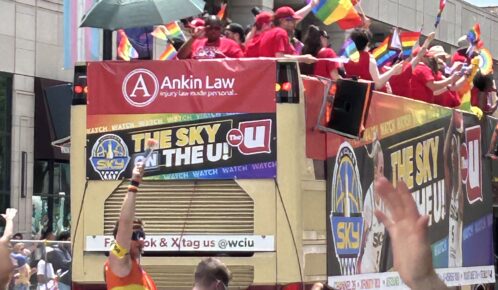ILLINOIS WORKERS’ COMPENSATION COMMISSION
NOTICE OF ARBITRATOR DECISION
______________________________ Case#
Employee/Petitioner
_______________________________
Employer/Respondent
On 5/3/2011, an arbitration decision on this case was filed with the Illinois Workers’ Compensation Commission in Chicago, a copy of which is enclosed.
If the Commission reviews this award, interest of 0.10% shall accrue from the date listed above to the day before the date of payment; however, if an employee’s appeal results in either no change or a decrease in this award, interest shall not accrue.
A copy of this decision is mailed to the following parties:
1067 ANKIN LAW OFFICE LLC
162 W GRAND AVE SUITE 1810
CHICAGO, IL 60654
___Injured Workers’ Benefit Fund (§4(d))
___Rate Adjustment Fund (§8(g))
___Second Injury Fund (§8(e)18)
_X_None of the above
STATE OF ILLINOIS )
)SS.
COUNTY OF COOK )
ILLINOIS WORKERS’ COMPENSATION COMMISSION
ARBITRATION DECISION
________________________ Case #
Employee/Petitioner
v. Chicago,
________________________
Employer/Respondent
An Application for Adjustment of Claim was filed in this matter, and a Notice of Hearing was mailed to each party. The matter was heard by the Honorable Arbitrator of the Commission, in the city of Chicago, on January 13, 2011. After reviewing all of the evidence presented, the Arbitrator hereby makes findings on the disputed issues checked below, and attaches those findings to this document.
DISPUTED ISSUES
A. ___Was Respondent operating under and subject to the Illinois Workers’ Compensation or Occupational Diseases Act?
B. ___Was there an employee-employer relationship?
C. _X_Did an accident occur that arose out of and in the course of Petitioner’s employment by Respondent?
D. ___What was the date of the accident?
E. ___Was timely notice of the accident given to Respondent?
F. _X_Is Petitioner’s current condition of ill-being causally related to the injury?
G. _X_What were Petitioner’s earnings?
H. ___What was petitioner’s age at the time of the accident?
I. ___What was Petitioner’s marital status at the time of the accident?
J. _X_Were all the medical services that were provided to Petitioner reasonable and necessary? Has Respondent paid all appropriate charges for all reasonable and necessary medical services?
K. _X_What temporary disputes are in dispute?
___TPD ___Maintenance _X_TTD
L. _X_What is the nature and extent of the injury?
M. ___Should penalties or fees be imposed upon Respondent?
N. ___Is Respondent due any credit?
O. ___Other _____
IC ArbDec 2/10 100 W. Randolph Street #8-200 Chicago. IL 60601 312/814-6611 Toll Free 866/352-3033 Web site: www.wcc.d.gov
Downstate offices: Collinsville 618/346-3450 Peoria 309/671-3019 Rockford 815/987-7292 Springfield 217/785-7094
FINDINGS
On November 17, 2008, Respondent was operating under and subject to the provisions of the Act.
On this date, and employee-employer relationship did exist between Petitioner and Respondent.
On this date, Petitioner did sustain an accident that arose out of and in the course of employment.
Timely notice of this accident was given to Respondent.
Petitioner’s current condition of ill-being is causally related to the accident.
In the year preceding the injury, petitioner earned $23,147.20; the average weekly wage was $1,006.40.
On the date of the accident Petitioner was 28 years of age, married with no dependent children.
ORDER
Temporary Total Disability
Respondent shall pay Petitioner temporary total disability benefits of $670.93/week for 53-5/7 weeks, commencing February 4, 2009 through March 1, 2010, as provided in Section 8(b) of the Act.
Medical benefits
Respondent shall pay reasonable medical services, pursuant to the medical fee schedule to Dr. to, , to , and to see PX6) as provided in Section 8(a) limited by the Medical Fee Schedule, Section 8.2 of the Act.
Permanent Partial Disability: Schedule injury
Respondent shall pay Petitioner permanent partial disability benefits of $604.84/week for 53.75 weeks, because the injuries sustained caused the 25% loss of the petitioner’s right leg, as provided in Section 8(c) of the Act.
RULES REGARDING APPEALS: Unless a party files a Petition for Review within 30 days after receipt of this decision, and perfects a review in accordance with the Act and Rules, then this decision shall be entered as the decision of the Commission.
STATEMENT OF INTEREST RATE: If the Commission reviews this award, interest at the rate set forth on the Notice of Decision of Arbitrator shall accrue from the date listed below to the day before the date of payment; however, if an employee’s appeal results in either no change or a decrease in this award, interest shall not accrue.
___________________________________ May 2, 2011
Date
IC ArbDec p.2
SUMMARY OF THE CASE
Petitioner was employed as a police officer for the . He testified that he had been employed in that position for a short period of time; approximately 5 months, and therefore was still in training on the day he alleges he was injured. On the day in question, November 17, 2008, the petitioner was working with a defensive tactics trainer, Officer Pontrelli when petitioner claimed he injured his right knee. Respondent denies that petitioner was injured in an accident that arose out of and in the course of his employment by the respondent and further denies that petitioner’s condition of ill being is causally related to an injury at work, (AX1).
FINDINGS OF FACTS
Petitioner testified that he was required to submit to a pre-employment physical examination before being hired by the village. (NB: The results of that examination were not made part of the record*.) Petitioner also testified that he attended the police academy prior to the accident in question.
Petitioner testified that on the day in question he was working with Sgt. . Who was demonstrating “takedown” tactics. The tactic in question is used by police officers to quickly and without warning bring a subject to the ground. The takedown occurs with the officer positioning himself standing and facing the subject but somewhat off-center, i.e. left leg to the left leg or right leg to right leg. The officer then uses his leg to “sweep” the leg of the subject out from under the subject and bring the subject to ground. Petitioner testified he was injured in one of the sweeps when he felt his knee pop after Sgt. swept his right leg. He said officer helped him up off the floor.
Petitioner testified that the injury occurred on a Monday evening. Thereafter, he was scheduled to be off work on Tuesday and Wednesday. He stated he filled out an accident report on Thursday when he returned to work. (NB: the accident report was not made a part of the record although respondent admits it received notice of the accident within the time limits stated in the Act.) Petitioner stated he did not ask for medical attention t that time because he thought the problem would clear up. In addition, he wanted to “man-it-up” because of his desire to be a police officer. He purchased a knee brace at Walgreens pharmacy and wore it after the November 17 injury.
Officer testified that on the day in question he demonstrated the takedown sweep three or five times after which he said the petitioner complained that his right knee hurt. He also confirmed that the petitioner completed the paperwork for an injury on duty. However, Sgt. testified that he swept petitioner’s left leg. Petitioner testified that he ultimately resigned from the Police Department on December 29, 2008. He stated that the reason for his resignation was that he could not successfully complete his defensive tactics training.
Petitioner testified that he previously injured his right knee at age 16. He underwent a surgical repair of the knee with internal fixation devices that were subsequently removed. He denied any problems with the knee between the time he was injured in his teenage years and the work accident he complains of on November 17, 2008.
Petitioner’s treating surgeon, (PX1)
Dr. testified that he first saw the petitioner on February 4, 2009. The history given the Dr. by the petitioner was that he was a police officer and approximately 2 months prior to the visit he was in jujitsu, was kicked on the lateral aspect of his knee. The knee swelled up for a few days but then the swelling went down. He continued to have deep pain and he felt that the knee would give out on him with activity. He also gave a history of breaking the knee sometime around 1997. Screws were put in the knee and were eventually removed. The surgery was done by one of the doctors in Dr. group. However, the records were no longer available.
Dr. performed a physical examination after which he diagnosed the patient was then ACL deficient right knee. He prescribed an MRI and that study confirmed to Dr. that the patient did in fact have an ACL tear. He recommended reconstructive surgery. He stated the injury was consistent with the type of accident described to him by the patient.
He also had the opportunity to review the May 4, 2009 independent medical evaluation conducted by Dr. . Dr. disagreed with the opinion of Dr. that the ACL deficiency was not a result of the November 17, 2008 work injury.
Dr. performed reconstructive surgery on September 17, 2009 where he did in fact find an ACL tear. Dr. reconstructed the knee using a patellar tendon allograft. He last saw the patient on February 15, 2010 at which time the patient reported he had been running and jogging in had no swelling or other activities with the use of a brace. Dr. noted that during the surgery he did not find arthritic changes, chondral injuries, or meniscal pathology which would indicate that the ACL tear was from a long standing injury.
Dr. opined that the condition of the knee was causally related to a November 17, 2008 work related injury. Based upon his last examination, (February 15, 2010) he told the patient he could in two weeks from that point be released to sporting activities and full work status.
Respondent’s examining physician, (RX2)
Respondent arranged for the petitioner to be examined by an orthopedic surgeon, Dr. , on May 4, 2009, (see exhibit 2 in RX2, the deposition of Dr. , and exhibit 2 in PX1, the deposition of Dr. .). Dr. had access to records of petitioner’s treating surgeon, Dr. . Dr. apparently also had access to and viewed a video clip of the petitioner engaged in police training which video is now in evidence.
*The respondent’s IME physician, Dr. also had access to the petitioner’s pre-employment physical examination on August 16, 2008 by Dr. . According to Dr. , Dr. wrote that the petitioner had a past history of two knee surgeries to the right side. The petitioner had no ongoing chronic medical problems. The examination by Dr. stated that the extremities were without edema and, no acute findings were noted on the examination.
Dr. opined that the petitioner had sustained an injury to his anterior cruciate ligament of the right knee. Dr. opined that the anterior cruciate ligament injury was not a result of the November 17, 2008 injury. He opined that it is most likely the anterior cruciate ligament tear occurred at the time of his right knee fracture, (at age 16). He also states the basis for his conclusion that the ACL was not torn on November 17, 2008 is that it would be extremely unlikely, if not unheard of, for a police officer to suffer an on the job acute anterior cruciate ligament tear and continued to work as a police officer and not be seen by a medical professional for 11 weeks. Dr. did opine that the petitioner was in need of additional medical treatment, ,including right knee arthroscopy.
*****
Petitioner testified that he is presently employed as a police officer at . He works full duty with no limitations on his physical activities.
ISSUES AND CONCLUSIONS
Did an accident occur that arose out of and in the course of petitioner’s employment by the respondent?
and
Is the petitioner’s present condition of ill-being causally related to the injury?
The arbitrator concludes that the petitioner has proven by a preponderance of the evidence that he sustained an injury on November 17, 2008 that arose out of and in the course of his employment by the respondent and his present condition of ill being is causally related to that injury. In reaching this conclusion the arbitrator has considered the persuasive opinion and reasoning of the patient’s treating surgeon, Dr.
In reaching this conclusion the arbitrator has also considered the contrary opinion of Dr. , who stated that the injury to petitioner’s right knee anterior cruciate ligament occurred when petitioner was 16 years of age and injured his knee into skiing accident. Dr. would have the arbitrator believe that the injury occurred at least nine years before November 17, 2008 even though there is no record of petitioner having any difficulty with the knee in that nine year period or that he even consulted with any physician regarding the knee during that nine year period. The opinion of Dr. is also contradicted by the pre-employment medical evaluation by Dr. , which failed to uncover any abnormalities in the right lower extremity. The apparent sole basis of the opinion of Dr. is that he cannot fathom the petitioner sustaining an acute injury on November 17, 2008 and not seeking medical care for 11 weeks until February 2009. The arbitrator notes that the petitioner did in fact terminate his employment with respondent on December 29, 2008 six weeks after the injury for the reason that he was unable to successfully complete the physical training required of him as a police officer.
What were petitioner’s earnings?
Petitioner claims that is average weekly wage calculated pursuant to section 10 of the Act was $964.46. Respondent contends petitioner’s weekly wage calculated pursuant to section 10 of the Act was $718.86.
Respondent’s exhibit number 3 is petitioner’s wage statement. The wage statement covers the period from June 8 ,2008 through November 22, 2008. Further, the wage statement shows that the petitioner is scheduled to work 40 hours per week at a rate of $25.16 per hour. The wage statement also reflects that the petitioner was paid every 14 days on Tuesdays. Petitioner was paid for 40 hours of work with his first paycheck. Thereafter, he was paid for 80 hours of work for the next 11 pay periods.
The arbitrator concludes that the petitioner worked 23 weeks beginning on the second week of the first pay period, June 15, 2008, ,through November 22, 2008. Petitioner’s earnings, excluding overtime during that period were $23,147.20. That figure when divided by the 23 weeks of employment, equal petitioner’s average gross weekly wage of $1,006.40, excluding overtime.
Were the medical services that were provided to petitioner reasonable and necessary?
Petitioner’s medical bills were received in evidence as PX6. The arbitrator concludes that petitioner has proven by a preponderance of the evidence that those medical bills constitute necessary medical care reasonably required to cure or relieve the petitioner from the effects of his injuries. The bills are the responsibility of respondent and shall be paid by them limited to the amounts allowable by to the Medical Fee Schedule.
Specifically, the respondent is liable for charges from Dr. PT, Hospital, and the Anesthesiologists.
The bill of $922.67 from is denied for failure of proof of the nature of services claimed by the provider.
What temporary benefits are in dispute?
The arbitrator concludes petitioner has proven by a preponderance of the evidence that he was temporarily totally disabled as a result of his work related accident from the date she first sought medical care, February 4, 2009, until he had a complete release to return to work as of March 1, 2010 by Dr. . Respondent shall pay the petitioner total temporary disability benefits in the amount of $670.93 per week for a period of 53 5/7 weeks.
What is the nature and extent of the injury?
The arbitrator concludes petitioner has proven by a preponderance of the evidence that he has sustained a 25% permanent and complete loss of use of his right leg as a result of his November 17, 2008 work related accident. This conclusion is based upon the nature of the injury and the testimony of Dr.
Respondent shall pay petitioner the sum of $603.84 per week for 53.75 weeks, as and for permanent partial disability compensation.



